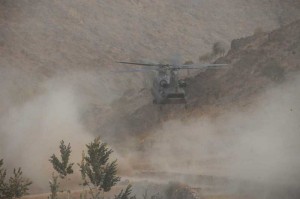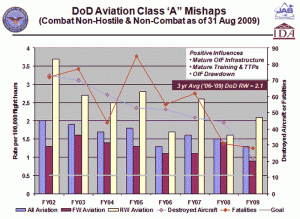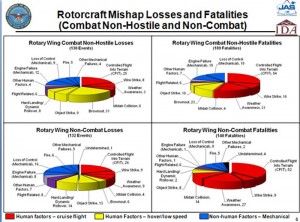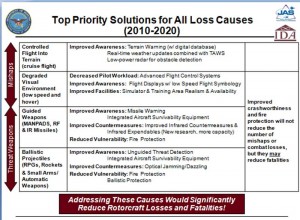Rotorcraft are significant contributors to military operations in Iraq and Afghanistan. They provide combat support, logistical lift, troop transport, medivac, and integrated C4ISR for the battlefield. The Iraq conditions have provided significant stress on the fleet and the need to provide engineering and maintenance solutions for operating in sand, heat and other stressful conditions.
Although important in Iraq, they are more significant in Afghanistan. The geography and topography of Afghanistan require the use of rotorcraft to shape effective con-ops in a disbursed battlespace and to support the Afghan allies in executing security missions.
We have discussed on the site the significant effort by NATO to provide a more effective approach to the support and maintenance of deployed helos in Afghanistan. These efforts are significant enhancers in availability and readiness for the fleet, but increased numbers will be required both for direct combat support and indirect support for the Afghan security and military forces.
Members of an Afghan international security force hold fast at a rally point,
800 meters south of the targeted compound, Chak District,
Wardak Province, Afghanistan, Oct. 14, 2009.
A CH-47 lands to retrieve members of the of joint force and return to base,
Chak District, Wardak Province, Afghanistan, Oct. 14, 2009.
Credit: 55th Combat Camera and shot 10/14/09
In addition to an increased investment in the rotorcraft fleet, an additional consideration will be shaping a new investment portfolio to ensure greater survivability of the fleet.
In a recent summary briefing of a study on rotorcraft survivability (from the slides approved for public release), the Institute for Defense Analysis provided some insight into the types of investments required. The study was conducted in response to Section 1043 of the 2009 National Defense Authorization Act and focused on losses of manned rotorcraft operating in the OEF/OIF timeframe (October 2001-December 2008).
The study indicated that there were 327 rotorcraft losses with 469 fatalities in this timeframe. Rotorcraft losses were due to the following causes: 20% to combat hostile action; 40% to combat non-hostile (mishaps in combat theater) and 40% to non-combat (mishaps out of theater). Notably, the combat loss rate was 6.6 times less and combat fatality rate was 4.6 times less than in Vietnam.
The study recommended investments in a number of areas to enhance the survivability of the fleet. Among the recommendations are the following:
- To further reduce combat losses: Increase rotorcraft investment to improve situational awareness, threat detection and jamming and damage tolerance;
- Provide effective guided and unguided threat detection and jamming for small and medium size rotorcraft are key technology requirements;
- To address the goal of 0.5 mishaps or less per 100,000 flight hours: increase investment in rotorcraft positional and situational awareness to include weather alerts, provide warning for flight hazards, terrain and obstructions, provide rapid response to hazards once detected, provide for improved component reliability;
- Advanced flight control systems with modern control laws are key enabling technologies;
- And to reduce personnel injuries and fatalities for combat threat losses and mishaps: improve airframe crashworthiness and crash protection for passengers and improve fire detection and suppression capabilities.
Elements of the “Study on Rotorcraft Survivability” should be covered during the OSD (Office of the Secretary of Defense) hosted Vertical Lift Aviation Industry / Academia Day on 27 Oct at 1300-1700 at the Sheraton Crystal City Hotel (https://www.enstg.com/Signup Conference code VER92726).
———-
***Posted October 21st, 2009





